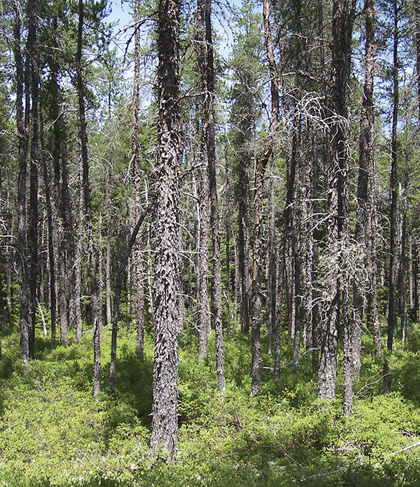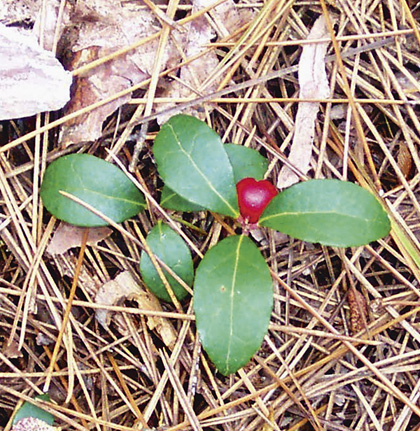
Forest Vegetation types - SP1
SP1 — Jack pine / Bracken – Teaberry
Pinus banksiana / Pteridium aquilinum – Gaultheria procumbens
SP1a — Black spruce variant
Picea mariana
 |
| Chase Lake, Cumberland County |
Concept: This early successional Vegetation Type (VT) has abundant jack pine, lesser but frequent black spruce, and a small suite of shade-intolerant understory associates. Occurrences dominated by black spruce, with lesser jack pine, are defined by the SP1a variant. SP1a stands either occur at a later successional stage or are characterized by less jack pine at the time of stand establishment. SP1 (Jack pine / Bracken – Teaberry) usually follows stand-replacing disturbance events such as fire or harvesting.
Vegetation: Jack pine is typically the dominant overstory tree, with lesser amounts of black spruce and shade intolerant hardwood species. The shrub layer may be densely occupied by black spruce and ericaceous species such as lambkill, lowbush blueberry and rhodora. (The presence of rhodora is particularly indicative of low site fertility). Herb layer diversity is low and dominated by bracken and teaberry. Schreber's moss dominates the bryophyte layer, with patches of reindeer lichens in more open areas.
Environmental Setting: SP1 occurs on dry, nutrient very poor to poor soils associated with glaciofluvial deposits or shallow, gravelly and/or coarse textured glacial tills. The majority of this VT is found in the Cumberland County portion of the Northumberland Lowlands ecodistrict. The black spruce variant can be found scattered throughout the Eastern and Atlantic Coastal ecoregions and is often interspersed with OW1 (Jack pine / Huckleberry – Black crowberry) on hummocky topography. This VT is more common in New Brunswick but mostly localized to the northeast. It is rare on Prince Edward Island.
Successional Dynamics: Dry, nutrient poor soils and stand-replacing disturbances strongly shape both the canopy structure and successional patterns of SP1. Historically SP1 stands originated from high intensity fires that initiated new, even-aged stands dominated by jack pine. The presence of jack pine decreases between disturbance events as it is replaced by black spruce (a species which has both greater longevity and the flexibility to regenerate either by seed or vegetative layering). As the potential impacts of fire are reduced through management, white pine and black spruce dominance will increase and the stand could transition to SP4a (White pine / Blueberry / Bracken variant Black spruce) or directly to SP5 (Black spruce / Lambkill / Bracken), the edaphic climax for this successional pathway.
Ecological Features:This closed canopy forest occurs as small to large patches. Jack pine is a shade-intolerant, fire-dependent species. This feature of the tree's life history means that fire suppression practices will likely reduce the abundance and frequency of this ecosystem in the landscape. Fire scars on residual pine are often found scattered through SP1 stands. Jack pine retains most of its seed in tightly closed cones that open to release large seed crops, after they are heated by fire. The acidity (low nutrient content) of the forest floor, due to the abundance of pine needles and ericaceous vegetation, reduces soil fauna, plant diversity, and vertebrate diversity and abundance. However, needles are an important food source for spruce grouse.
 |
| Teaberry |
Distinguishing Features: Jack pine is diagnostic for this vegetation type found on dry, poor soils. Ericaceous species such as lambkill, blueberry and rhodora are common. Reindeer mosses are common. The variant SP1a is dominated by black spruce with lesser jack pine.
| Slope Position: | Upper6 Level2 Crest1 Middle1 |
Surface Stoniness: |
(Non - Slightly)8 (Moderately)1 nd1 |
Bedrock Outcrop: |
(Non-rocky)9 nd1 |
Elevation Range: |
21 - 82m |
Slope Gradient: |
Gentle6 Level2 nd2 |
Aspect: |
East2 South1 West3 None3 nd1 |
Exposure: |
Moderate8 Mod. exposed1 nd1 |
Microtopography: |
Slightly4 Moderately3 Level1 Strong1 nd1 |
Drainage: |
Moderately well3 Rapid3 Well3 nd1 |
Soil Type: |
ST24 ST13 ST32 nd1 |
Parent Material: |
Glacial till9 Glaciofluvial1 |
Rooting Depth (cm): |
(30-45)2 (>45)7 nd1 |
Duff Thickness (cm): |
(0-5)1 (6-10)6 (11-20)2 nd1 |

